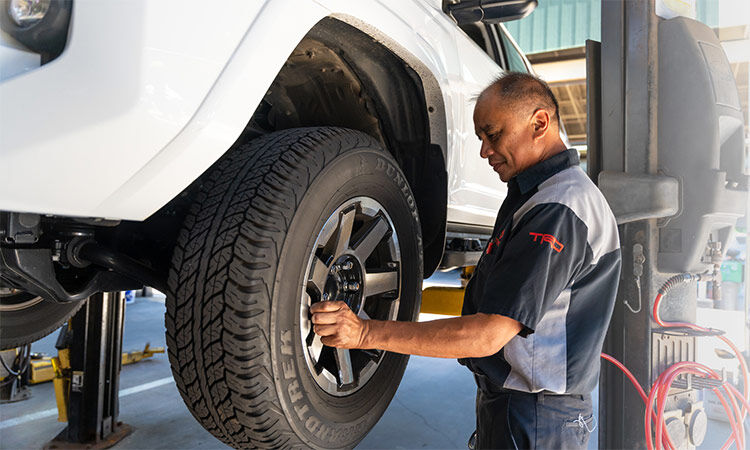Morris Tires: Where GMC Tire Service Fulfills Top Quality
Morris Tires: Where GMC Tire Service Fulfills Top Quality
Blog Article
Tire Solution: The Impact of Weather Condition Conditions
When it comes to guaranteeing optimum efficiency and security on the road, comprehending the influence of weather condition problems on tire service is important. GMC Tire Service. In this conversation, we will check out the complex relationship in between weather condition problems and tire service, losing light on the significance of weather-specific tire maintenance techniques and considerations.
Heat and Tire Efficiency
When revealed to heats, tires experience adjustments in performance that can significantly affect automobile security and handling. The warm generated from prolonged driving or warm weather problems causes the tire rubber to soften, causing reduced walk life and enhanced wear. As the rubber ends up being softer, the tire's hold when driving diminishes, influencing braking ranges and total traction. In severe cases, too much warmth can also trigger tire blowouts, positioning a serious safety danger to the automobile and its passengers.

Cold Weather Condition Impacts
Cold weather condition conditions can have a substantial influence on tire performance and security. In cool weather condition, tires might additionally lose air pressure much more rapidly, which can affect handling and fuel performance.
To alleviate the impacts of winter on tires, it is essential to consistently inspect tire pressure and inflate them to the maker's recommended degrees. Making use of winter season or all-season tires designed for cool weather problems can likewise improve grip and grip on icy or snowy roadways. Appropriate tire maintenance, including normal inspections for wear and damages, ends up being much more vital throughout colder months to make sure ideal performance and safety and security.
Rainy Issues Impact
Tires with damaged footsteps are much more prone to hydroplaning, where a layer of water constructs up between the road and the tire surface, leading to loss of grip. To fight this, drivers ought to on a regular basis examine their tires for ample step deepness and consider investing in tires especially made for wet problems.
In addition, wet weather condition can also decrease exposure, making it testing for motorists to see the road ahead plainly (GMC Tire Service). In such problems, it is essential to adjust driving speeds as necessary and preserve a secure adhering to distance to enable sudden quits. Correctly inflated tires visit this site can also aid in maintaining control on damp roadways by supplying far better handling and grip
Snow and Tire Safety
Snow-covered roadways posture distinct obstacles for vehicle drivers, stressing the importance of proper tire selection and maintenance. When driving in snowy problems, having the best tires can make a considerable distinction in security and efficiency. Winter season tires are designed with unique rubber substances and tread patterns to give much better traction on snow and ice contrasted to all-season tires. The much deeper treads and sipes of winter months tires assist grip the roadway better, decreasing the risk of sliding and gliding.

Moreover, chauffeurs must consider installing tire chains in severe snowy conditions. Tire chains supply extra traction by clutching the snow and ice, improving stability and control. It is important to adhere to producer instructions when setting up and using tire chains to protect against damage to the tires and car (GMC Tire Service). By selecting the ideal tires, maintaining appropriate inflation, go to website and thinking about additional traction aids like tire chains, vehicle drivers can improve their safety and security when browsing snow-covered roadways.
Weather-Related Tire Upkeep
When confronted with different weather, correct tire upkeep comes to be a critical aspect of automobile security and performance. Weather-related tire maintenance includes a variety of practices targeted at guaranteeing optimum tire function and longevity in various weather scenarios. One key facet of weather-related tire maintenance is tire pressure regulation. Rising and fall temperature levels can cause tire pressure to vary, impacting grip and gas performance. Regularly examining and readjusting tire pressure according to supplier recommendations is browse around here crucial for secure driving in changing weather conditions. Additionally, tire step deepness plays a considerable duty in managing various climate components. Tires with appropriate step depth provide much better hold on damp or icy roadways, decreasing the threat of hydroplaning or skidding. When step wear gets to a particular deepness is crucial for keeping grip and security in damaging weather, examining tire walk regularly and changing tires. By focusing on weather-related tire upkeep, motorists can enhance security, improve car performance, and prolong the lifespan of their tires.
Final Thought
In final thought, weather have a considerable effect on tire performance and safety. From heat affecting tire stress and use to winter decreasing grip, it is important to consider the weather when keeping and making use of tires. Rainy conditions can reduce grasp and lead to hydroplaning, while snow can enhance the threat of accidents if tires are not effectively furnished. Weather-related tire upkeep is vital in making sure ideal efficiency and security when driving.
In this discussion, we will certainly discover the detailed relationship between weather problems and tire solution, dropping light on the value of weather-specific tire upkeep practices and factors to consider.

Report this page